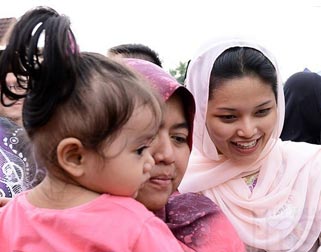|
Recollections:
Mosaic of the Malay Race
The Malay influence commenced when a Malay Prince was deported by the
Dutch around the 18th century. Hence distinctive Malay characteristics
and traits were cast on the early Sinhalese ever since that time. UNESCO
declared that the Malay language is being endangered because this
community is moving away from their mother-tongue to converse in
Sinhalese, Tamil or English. Intermarriage has taken place but they
maintain a good rapport with people they also live among.
As from the reign of King Sena (888-858) the ancient civilised era,
the Malays have existed pretty well in this island. Many Malays lived in
Ceylon when the Dutch ruled. The British took over in 1815 and some of
the Malay tribe opted to make Indonesia their homeland, some stayed back
to become soldiers, policemen or to join the Fire Brigade Regiment.
 The
first Malay newspaper Alamat Lanka Pura was published around 1925. Also
at that time a friendly 'medicine man' attended to the sick going from
house to house administering local herbs and unguents. The
first Malay newspaper Alamat Lanka Pura was published around 1925. Also
at that time a friendly 'medicine man' attended to the sick going from
house to house administering local herbs and unguents.
Malay ancestors who lived in Ceylon (Sri Lanka) belonged to the Malay
Archipelago and held fast to their culture and customs. Practising
Islam, they recited prayers in Arabic and celebrated Islamic festivals.
Today, they are not restrained or restricted in participating in any Sri
Lankan event.
The typical Malay male attire was a vivid cloth, a colourful batik
shirt and the head-gear called 'Sonka'. Women wore the 'Baju Kurung' a
wrap-around cloth in vivacious patterns or prints.
It was rather silky and was teamed with a long-sleeved blouse.
Glittering thonged slippers were chosen. Her shiny, long hair was pinned
back with ornamental hair-combs.
She could be so alluring as she tripped along the narrow roads of
long ago to call on her neighbour or friend. Her tasselled parasol,
heavily-lashed eyes, high cheekbones and olive complexion made her so
attractive. They attended weddings elegantly dressed, exuding the
fragrance of rose-water.
The bride in satin and lace western attire sat on her flower
be-decked settee awaiting the bridegroom who would uncover her face veil
until the groom arrives and places jewellery on her and a wedding ring
on her finger.
The groom wore a designed sarong, a satin tunic and a fez-cap.
The marriage ceremony was and continues to be grand and lavish.
Guests are served cake, Nasi Goreng or ghee rice.
The sweetened, coloured drink had tiny black seeds(Kasa Kasa)
floating on top. Dessert was delicious 'Vatalappan' and sugar-coated
musket with fragments of cadjunuts in it.
Dr. Ronit Ricci came in search of information regarding the Malays.
She discovered scripts in Gundal and Arabic books printed in Romanized
Malay with translations into Sinhalese and Tamil.
She received documents and old Malay family photographs (vague and
discoloured) from certain families. People in Trincomalee gifted her
with antiquated letters, scripts, journals and disintergrating personal
certificates all tarnished with age.
She also glanced through a collection of documents and pages (now
kept safe in the National Archives). From the Quran which had been
translated into Malay.
She took copies of Malay poetry and stories 'Hikayat' from the Quran
and booklets of 1920.
An article in another weekly highlighted hair ornaments. Percival's
1803 report said that the males wore perfectly manufactured turtle-shell
hair-combs of the finest lustre. The Malay lady adorned her coiffure
with elaborate hair-pins and polished pieces of turtle shell for special
occasions.
The Malays are hospitable folk. They capture the Malay spirit of
living amicably in our lovely island.
- Caryl Nugara
|

